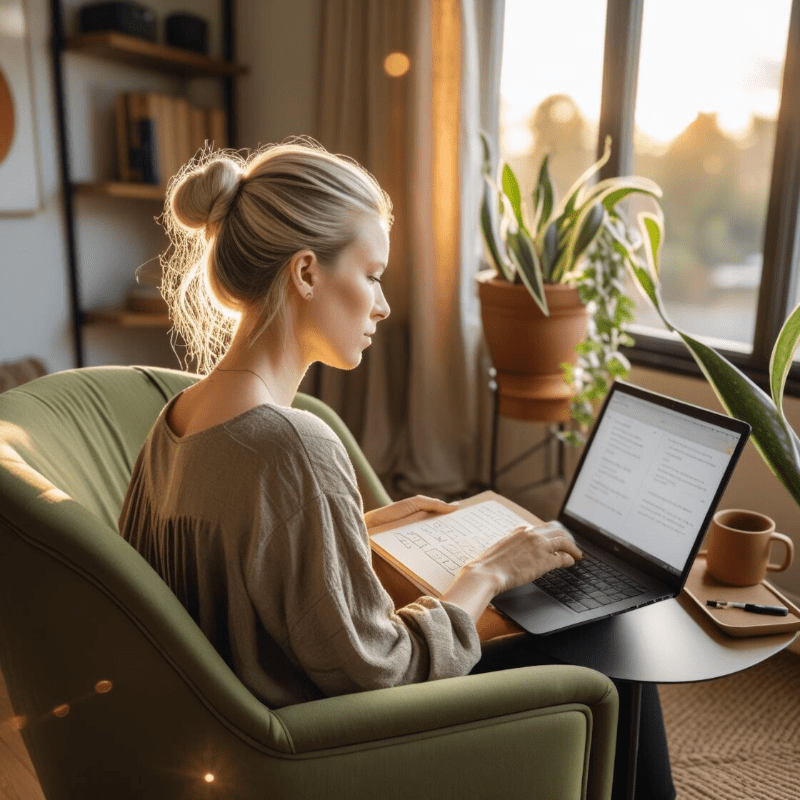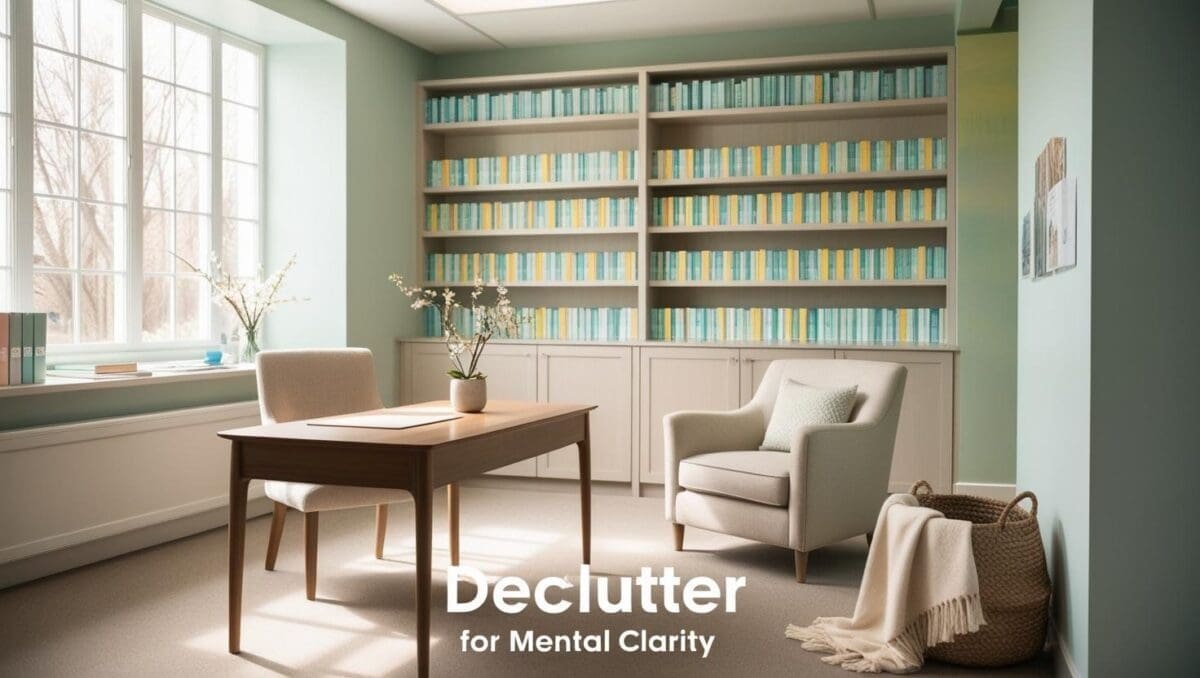How Minimalist Design Impacts the Therapy Experience
A therapy office doesn’t need to be filled to feel safe—it needs to be intentional. In a world of overstimulation and emotional noise, minimalist design offers more than visual calm—it creates space for clarity, reflection, and grounded connection.
As a counselor, I’ve seen how even small design changes can transform the energy of a room. When the environment feels balanced and clutter-free, clients are more likely to feel centered too.
In this article, we’ll explore the science-backed psychological benefits of minimalist therapy office decor and how to create a space that promotes calm, trust, and emotional well-being.

1. How Clutter Affects the Brain and Emotional Regulation in Therapy Spaces
Clarity begins in the environment.
In therapeutic work, we often encourage clients to slow down, tune in, and find calm amid life’s chaos. But if the therapy space itself feels cluttered or overstimulating, that process becomes more difficult. Environmental psychology confirms what many therapists already intuitively know: a messy, disorganized space can lead to mental fatigue, emotional tension, and reduced focus.
Minimalism in therapy offices isn’t just about style—it’s a way to protect cognitive bandwidth and create emotional space for clients to feel safe, grounded, and open.
🧠 The Psychological Effects of Clutter in Therapy Rooms:
✔ Increased Stress Hormones
Studies have found that cluttered environments elevate cortisol levels, especially in women. For clients already navigating anxiety or trauma, visual overload can compound internal stress.
✔ Reduced Focus & Mental Clarity
Too many visual inputs compete for attention. In a therapy session, that can make it harder for clients to stay present or reflect deeply on emotions and thoughts.
✔ Emotional Discomfort & Distrust
A disorganized space can unintentionally communicate chaos, instability, or lack of safety. Clients may feel hesitant to open up if the room feels chaotic or overwhelming.
🌿 Therapist Insight: A minimalist space isn’t about being sparse—it’s about creating emotional clarity. The goal is to offer a backdrop that helps clients center themselves, not react to their surroundings.

2. The Role of Minimalist Colors in Emotional Regulation
Color isn’t just visual—it’s emotional.
In therapy spaces, color choices can significantly influence how safe, open, and grounded clients feel. Color psychology tells us that certain hues can calm the nervous system, support trust, and even influence emotional processing. That’s why minimalist design so often leans into soft, neutral, and earth-toned palettes—they do more than look serene. They feel that way, too.
Unlike bold or saturated colors that demand attention, minimalist hues act as a quiet backdrop to emotional work. They reduce overstimulation, promote clarity, and help both therapist and client stay present.
🎨 Best Minimalist Colors for Therapy Offices & Why They Work:
✔ Warm Whites & Creams
Create a sense of openness and simplicity. These tones make a space feel airy and uncluttered—encouraging reflection and breath.
✔ Soft Beiges & Taupes
These grounding shades offer warmth without distraction. They feel natural, calm, and comforting—especially helpful in trauma-informed spaces.
✔ Muted Earth Tones
Colors like sage green, terracotta, or clay bring in natural energy. They connect us to the earth and support emotional regulation through biophilic design principles.
✔ Blush & Dusty Pinks
Soft and nurturing, these hues bring gentle femininity into the room—subtly reinforcing care, compassion, and emotional openness.
✔ Dusty Blues & Soft Grays
Blues are often associated with trust, peace, and stability. These cool tones help balance out warmer elements and add emotional spaciousness.
🌈 Therapist Tip: Use 2–3 complementary tones and repeat them through walls, textiles, and decor. Cohesion helps the space feel emotionally safe and visually calm.

3. The Impact of Open Space and Simplicity on Mental Clarity
Breathing room matters—emotionally and spatially.
In therapy, clarity is everything. And that clarity begins with the space itself. A minimalist office layout—with open space, purposeful furniture, and limited visual noise—does more than look clean. It sends a powerful message: This is a safe, focused space where your thoughts are welcome, and your feelings have room to unfold.
When we strip away the excess—unused chairs, cluttered bookshelves, or overly decorative objects—we allow the room to breathe. And in turn, clients feel they can breathe, too.
🛋️ How a Minimalist Layout Enhances the Therapeutic Experience:
✔ Encourages a Sense of Psychological Safety
Open, tidy spaces create predictability and calm, which are foundational for clients dealing with trauma, anxiety, or overwhelm. The environment becomes a silent co-therapist, holding space with you.
✔ Improves Focus and Presence
When the eye isn’t pulled in a dozen directions, the mind can settle. A clutter-free environment helps both client and therapist stay attuned to the emotional work at hand.
✔ Supports Emotional Processing
A layout that includes intentional negative space (i.e., empty floor or wall areas) reflects emotional spaciousness. It gives clients room to pause, reflect, and connect more deeply with themselves.
📐 Therapist Tip: Arrange your seating in a soft triangle—not rigidly across from the client. Keep one corner of the room open to symbolize safety, exit, and unobstructed movement.

4. The Psychological Benefits of Minimalist Furniture and Decor
Comfort doesn’t require excess—just thoughtful design.
Minimalist furniture and decor aren’t about creating a sterile or empty room. When chosen intentionally, they help create a therapy space that feels calm, supportive, and emotionally grounded. The textures, shapes, and simplicity of your furnishings play a subtle yet powerful role in how safe, focused, and regulated your clients feel.
By emphasizing open space, breathable materials, and visually quiet objects, you reduce sensory overload while still expressing warmth and professionalism. The goal isn’t perfection—it’s presence.
🪑 Essential Minimalist Elements for a Grounded Therapy Office:
✔ Comfortable, Ergonomic Seating
Choose chairs that are both supportive and visually light. Avoid bulky designs; instead, opt for slim arms, curved backs, and soft upholstery in neutral tones. Comfort fosters safety.
✔ Light, Airy Furniture Pieces
Select pieces with open bases, natural wood tones, or thin legs. This creates the illusion of more space and helps the room feel grounded rather than crowded.
✔ Minimal Yet Meaningful Decor
One intentional item speaks louder than ten mismatched accessories. Think:
- A single piece of calming art
- A small potted plant or eucalyptus stem
- A ceramic or stone vase in an earthy tone
These quiet objects add life and beauty without visual noise.
✔ Layered Natural Textures
Instead of color and pattern, use texture to add warmth:
- Linen or gauzy curtains
- A soft wool or jute rug
- Light wood furniture
- Cotton or boucle throw pillows
🌿 Therapist Tip: Choose 2–3 materials you love (like wood, ceramic, and linen) and repeat them subtly in different areas of the room to create a sens

5. Using Natural Light and Soft Lighting for Emotional Comfort
Light is one of the most powerful tools in your therapy space.
Lighting influences not only how your office looks—but how it feels. In therapy, that feeling matters. The right lighting can help clients regulate their nervous systems, feel more emotionally grounded, and relax into the therapeutic process. A minimalist space with soft, intentional lighting sets the stage for healing.
Whenever possible, let natural light lead the way. But when it’s not available or needs supplementing, opt for layered, warm-toned light sources that feel cozy and inviting rather than clinical or cold.
💡 Best Lighting Practices for a Minimalist Therapy Office:
✔ Maximize Natural Light
Use sheer or linen curtains to diffuse sunlight without blocking it. Position chairs to face or gently angle toward windows—natural light boosts mood and supports emotional openness.
✔ Choose Warm-Toned, Soft LED Bulbs
Avoid cool white or fluorescent lights, which can feel harsh and overstimulating. Instead, choose bulbs labeled 2700K–3000K (soft white) to promote calm and emotional safety.
✔ Incorporate Cordless & Rechargeable Lamps
These are ideal for small or shared spaces. They offer flexibility, reduce cord clutter, and allow you to place warm light exactly where it’s needed—especially near client seating.
✔ Try Wall Sconces or Pendant Lighting
These options save desk or floor space while providing beautiful ambient light. Look for frosted shades, curved fixtures, or neutral metals to keep the minimalist vibe intact.
🕯️ Therapist Tip: Use lighting as a symbolic boundary. Dimming lights slightly at the start of session or using different lamps for different times of day can support emotional transitions.

The Psychology Behind Minimalist Design
Minimalist design focuses on simplicity, space, and purpose. From a psychological standpoint, clean and clutter-free environments help reduce cognitive load. Clients are more likely to feel emotionally regulated in spaces that are not visually overwhelming.
According to environmental psychology, cluttered rooms can increase feelings of anxiety and overstimulation. In contrast, a minimalist setting creates a sense of control, stability, and calm.
Reference: Psychology Today – Why Mess Causes Stress
How to apply it: Use only essential furniture and remove unnecessary decor. Opt for one focal point per room—like a calming wall print or a simple bookshelf.
Minimalism Supports the Therapeutic Relationship
In minimalist spaces, there are fewer distractions. This helps clients focus more fully on the conversation, their emotions, and their internal experiences. It also allows the therapist’s presence to feel stronger and more grounded.
Minimalist design sends a subtle message: “This is your space, and there’s nothing here to distract from your process.”
Therapist tip: Keep the furniture layout simple and centered. A low table, two comfortable chairs, and a soft rug may be all you need.
Related: Minimalist Therapy Office Essentials
Decluttering as a Form of Care
Clients pick up on everything, including your space. When your office is tidy, intentional, and calm, it communicates safety and professionalism. A cluttered space can unintentionally reflect chaos or emotional overwhelm.
“The state of our space often mirrors the state of our mind. A clean, minimal office helps create mental spaciousness—for both therapist and client.”
How to apply it: At the end of each day, take 5 minutes to reset your space. Clear your desk, fluff the pillows, and return items to their place. Think of it as preparing the room to hold space again tomorrow.
Related: Declutter Your Therapy Office – A Minimalist Approach
Minimalism in therapy offices isn’t about cold or clinical spaces—it’s about creating breathing room. When we remove the excess, what’s left is space to connect, reflect, and heal.
Whether you’re designing your first office or refreshing your current space, let your decor support your purpose. Let it hold space. Let it say less—and mean more.
Looking for more inspiration?
- Minimalist Lighting Solutions
- Cozy Therapy Office Ideas
- Therapy Office Wallpaper with a Dark Aesthetic
Affiliate Disclosure: This post may contain affiliate links. I only recommend items I believe support the therapeutic space. If you purchase through a link, I may earn a small commission at no cost to you.

About the Author
Hi, I’m Eve, a former school counselor with a master’s degree in School Psychology and a passionate advocate for children and families navigating sensory challenges. As a mom of children with sensory sensitivities, I deeply understand the journey special-needs parents face, and I dedicate myself to researching and sharing practical solutions to help children thrive and feel comfortable in their bodies. My goal is also to empower counselors, therapists, and psychologists with creative strategies and supportive resources to enrich their everyday practice. When I’m not writing or exploring new therapeutic approaches, you’ll find me spending quality time with my family and continually seeking inspiration from everyday moments.


